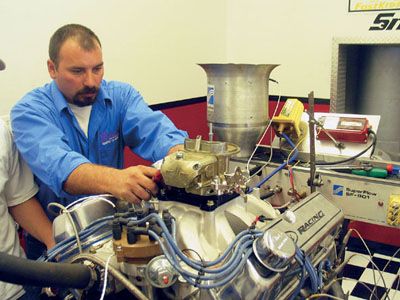
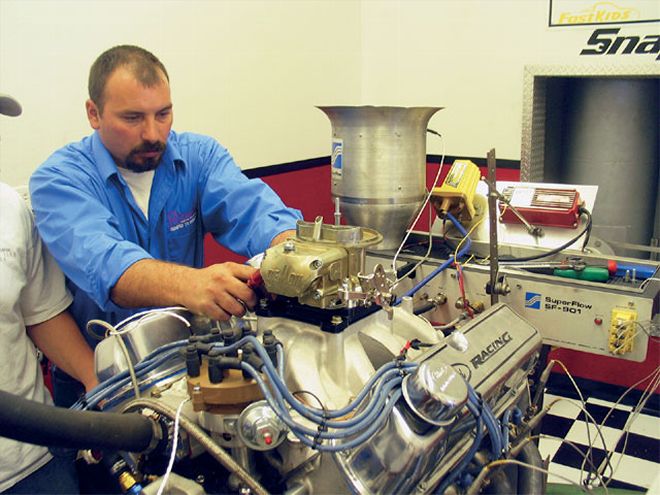 Crate engines from General Motors, Ford, and Chrysler took their turns in the dyno room for a head-to-head comparison.
Crate engines from General Motors, Ford, and Chrysler took their turns in the dyno room for a head-to-head comparison.
The crate engine has become a player in short-track racing. In most cases, the track or series limits the engine selection to that of one manufacturer, but there are a few cases where attempts are being made to bring in multiple crate engines.
One attempt is being made in the FASTRUCK Series. Promoter Bobby Diehl brought in the General Motors' ZZ4 crate engine and decided to see what he could do to get the other manufacturers involved. With the help of some willing competitors, Diehl has taken steps to find out.
Earlier this year, an engine was borrowed from teams running each type-Chevrolet, Ford, and Dodge. They were taken to the engine dyno of Richards Racing Engines in Haines City, Florida. The Chevrolet went into the cell first, followed a few weeks later by the Ford. The Dodge, which required a set of headers that took some time to acquire, was last to visit.
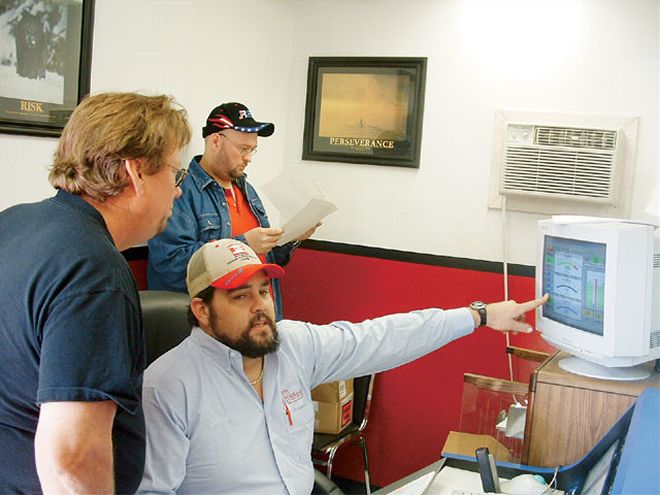 Richards Race Engines head Bobby Richards explains some of the readings and processes that will be done with the Chevy ZZ4 crate engine hooked up in the dyno room.
Richards Race Engines head Bobby Richards explains some of the readings and processes that will be done with the Chevy ZZ4 crate engine hooked up in the dyno room.
The idea was to get the lay of the land on the important numbers. Each manufacturer provides this basic information to its customers, but those numbers generally pertain to the four-barrel carburetor. This series mandates a two-barrel carburetor, so there would be some difference in the performance numbers. The intent was to find out what needed to be done to get the engines to perform within a few horsepower or a couple of pounds of torque.
Scotty McLendon of McLendon Carburetors was an active participant in the testing. His carburetion knowledge gave insight into the changes needed to get the figures in the ballpark.
The majority of the testing used the BG Fuel Systems Demon two-barrel that was unveiled late last year. For ease of comparison, the removable sleeve (RS) model was selected. The carburetor's role in the engine's performance could be changed in minutes by simply pulling out a sleeve of one size and inserting a sleeve of a different size.
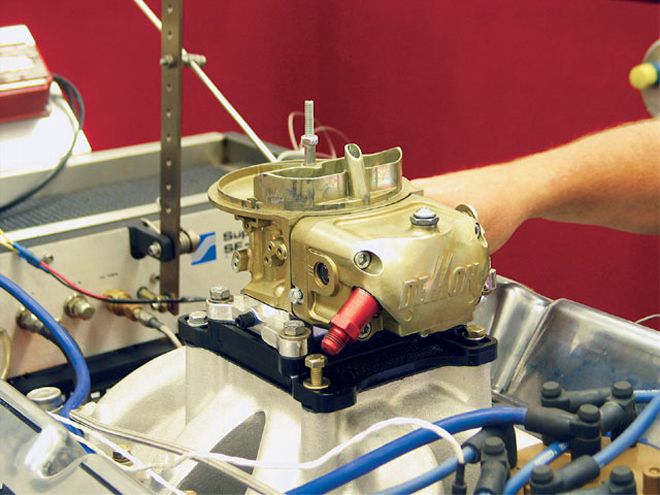 The primary carburetor is the BG two-barrel Demon, which features removable sleeves. Changing the sleeve size will allow a better look at regulating the engines.
The primary carburetor is the BG two-barrel Demon, which features removable sleeves. Changing the sleeve size will allow a better look at regulating the engines.
Chevy Test The ZZ4 crate engine (PN 24502609) is among the most popular engines available for racing. Most of the sanctions that mandate the crate engine chose the ZZ4 for a number of reasons. With the steel roller tappet camshaft (0.474-inch intake/0.510-inch exhaust valve lift), the engine made 355 hp at 5,250 rpm and torque figures in excess of 300 across the range. However, that was utilizing the four-barrel carburetor, so the figures were tossed out.
In the first test, the 500-cfm Demon two-barrel was fitted with silver (1.373) sleeves. Using 79 jets and 34-degree timing, the first test was conducted with peak horsepower at 5,900 rpm (see Figure 1).
After the first test, the carburetor was removed to change the sleeves. The jet size was changed to a 77 jet, and the green sleeves (1.28) were inserted. This test drew the numbers down with the engine recording its peak horsepower of 307 at 5,700 rpm (see Figure 2).
A final sleeve change brought the red (1.4) big sleeves into the carburetor. The jets were changed to 81. There was no change in timing (see Figure 3).
Bring on the Ford The selected Ford engine was the M6007A351E (forged pistons). This 351ci engine was pulling 385 hp with headers and a 785 carburetor. It featured a single plane Victor Jr. intake and the 5.8L Sportsman II race block.
The BG carburetor was bolted onto this engine, which proved itself stout right from the start. Using the silver sleeves, 78 jets, and 36 degrees of timing, it was a horsepower hero (see Figure 4).
The swap in sleeves was made to the green sleeves. In the process, torque and horsepower figures increased. The horsepower numbers kept growing to the 6,000-rpm range, so the peak may not have been realized in this test (see Figure 5).
The final test for the Ford engine came with the insertion of the red sleeves. This engine showed differences, but really started picking up after 4,500 rpm, hitting 380 hp at the 5,400-rpm range, a favorable range for many of the competitors (see Figure 6).
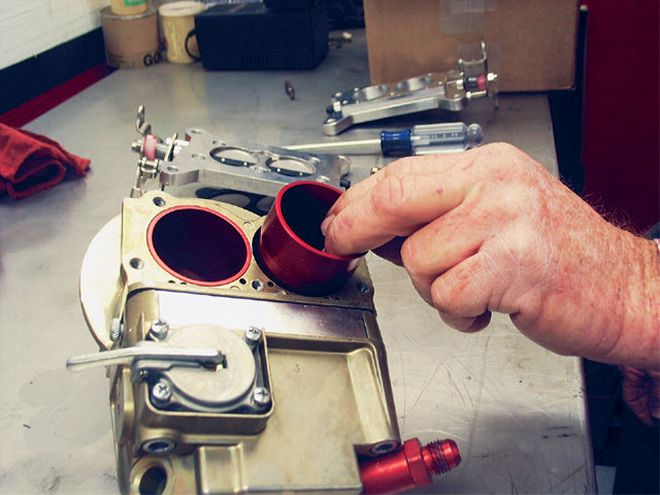 Removing the sleeves was a simple task that kept the dyno from an abundance of down time.
Removing the sleeves was a simple task that kept the dyno from an abundance of down time.
The Dodge Test After the proper headers were located and the dyno time was arranged, the Dodge (PN P5249499) was a 360 V-8 crate Magnum that advertised 380 hp on the four-barrel carburetor. It is a 9:1 compression engine that features a cam profile very similar to the competitors.
As the test was underway, it was obvious there was something amiss. This particular engine had some internal problems and would not be a good representation. The powerplant soldiered along to produce the numbers seen in Figure 7, but those figures have to be taken with a grain of salt, considering the condition of the engine.
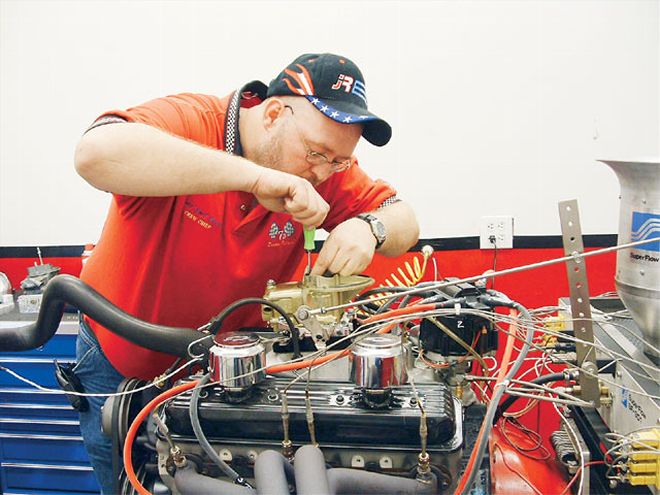 FASTRUCK Tech Director Carl Green makes an adjustment on the Chevy ZZ4.
FASTRUCK Tech Director Carl Green makes an adjustment on the Chevy ZZ4.
Another Dodge was rounded up some time later, but the carburetor that had been used on the other tests was not available. A Scotty McLendon-prepared Holley 4412 was used to get some idea about the Dodge performance (Figure 8). While this is not exactly comparing apples to apples, it does give a basic understanding.
Conclusion In a year that features elections, it's not unusual to reach the conclusion that there is no conclusion. In this case, the engines were tested to determine the possible next step or steps that the sanction must take. There are a number of routes that can be taken, ranging from weight placement, mandating a particular sleeve, or changing components. It has been suggested that the GM crate engine numbers could be improved with a single plane manifold, used by the others. In order for this to be accomplished, that option would have to be available at the factory; otherwise, competitors are changing the product and the intent of the experiment.
Crate engines are expected to be mandated in 2005 for this series. In the meantime, officials will look at the numbers and make their decisions. If your series is going to offer options on the engine package, you can learn from others to see if this is a workable option in your neck of the woods.
Figure 1Chevy 24502609, Silver sleeves, Corrected torque and power
RPM Torque HP BSFC 3000 383.2 218.9 .538 3100 379.8 224.2 .543 3200 378.7 230.7 .515 3300 379.4 238.4 .518 3400 380.6 246.4 .511 3500 380.0 253.2 .530 3600 376.7 258.2 .497 3700 376.5 265.3 .496 3800 369.9 267.6 .497 3900 370.1 274.8 .503 {{{4000}}} 371.5 282.9 .496 4100 370.5 289.2 .497 4200 370.7 296.4 .497 4300 369.6 302.6 .496 4400 364.1 305.0 .519 4500 357.5 306.3 .529 4600 351.8 308.2 .526 4700 346.5 310.1 .525 4800 343.1 313.6 .526 4900 337.7 315.1 .545 {{{5000}}} 331.2 315.3 .567 5100 326.2 316.8 .562 5200 321.5 318.4 .575 5300 313.2 316.1 .556 5400 309.3 318.0 .572 5500 304.6 318.9 .574 5600 293.1 312.5 .595 5700 290.1 314.8 .596 5800 292.3 322.8 .577 5900 291.6 327.6 .555 {{{6000}}} 257.8 294.6 .655 6100 270.0 313.5 .606 6200 252.2 297.8 .647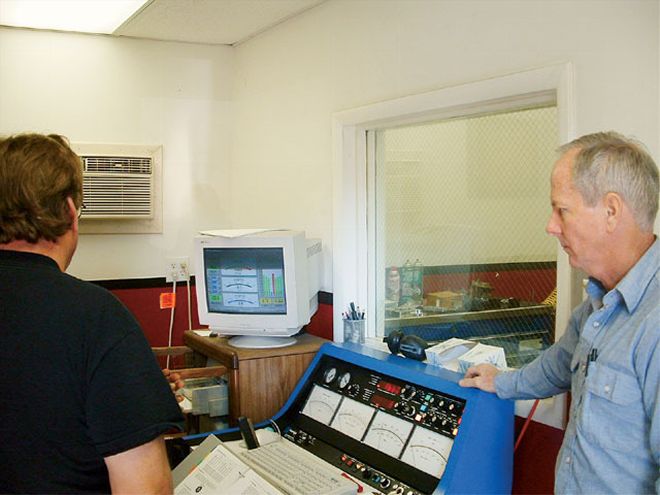 Scotty McLendon (right) provided his expertise and time to the project.
Scotty McLendon (right) provided his expertise and time to the project.
Figure 2 - Chevy 24502609, Green sleeves, Corrected torque and power
RPM Torque HP BSFC 3000 375.8 214.7 .621 3100 375.1 221.4 .604 3200 372.7 227.1 .562 3300 374.7 235.4 .564 3400 372.0 {{{240}}}.8 .564 3500 369.5 246.3 .550 3600 368.3 252.5 .542 3700 363.5 256.1 .547 3800 361.5 261.6 .565 3900 360.5 267.7 .550 {{{4000}}} 359.3 273.6 .537 4100 355.7 277.7 .571 4200 355.9 284.6 .564 4300 356.1 291.5 .549 4400 350.7 293.8 .565 4500 346.1 296.5 .564 4600 339.8 297.6 .577 4700 334.7 299.5 .556 4800 331.7 303.1 .581 4900 327.4 305.5 .581 {{{5000}}} 319.1 303.8 .592 5100 314.4 305.3 .598 5200 307.6 304.5 .602 5300 302.2 304.9 .627 5400 296.6 304.9 .649 5500 291.6 305.4 .665 5600 287.0 306.1 .662 5700 283.3 307.5 .639 5800 268.9 296.9 .689 5900 251.7 282.8 .705 {{{6000}}} 261.1 298.3 .670 6100 245.8 285.5 .696 6200 249.6 294.6 .680Figure 3 - Chevy 24502609, Red sleeves, Corrected torque and power
RPM Torque HP BSFC 3000 379.1 216.5 .529 3100 377.9 223.0 .534 3200 378.4 230.5 .536 3300 378.7 237.9 .508 3400 376.9 244.0 .511 3500 377.4 251.5 .506 3600 374.3 256.5 .511 3700 371.6 261.8 .512 3800 369.7 267.5 .513 3900 368.3 273.4 .508 4000 365.9 278.6 .507 4100 366.3 285.9 .500 4200 364.8 291.7 .493 4300 364.1 298.1 .498 4400 361.2 302.6 .505 4500 355.3 304.4 .500 4600 351.4 307.7 .524 4700 344.8 308.5 .527 4800 338.9 309.7 .498 4900 332.8 310.5 .528 5000 328.7 312.9 .517 5100 323.3 313.9 .513 5200 321.1 317.9 .528 5300 315.0 317.9 .533 5400 310.4 319.2 .531 5500 304.3 318.7 .550 5600 292.3 311.7 .572 5700 280.6 304.6 .597 5800 271.8 300.2 .622 5900 266.5 299.3 .619 6000 267.6 305.7 .594 6100 246.4 286.1 .652 6200 250.9 296.1 .603
Figure 4 - Ford M6007-A351E, Silver sleeves, Corrected torque and power
RPM Torque HP BSFC 3000 344.3 196.7 .605 3100 342.9 202.4 .642 3200 349.0 212.6 .639 3300 344.6 216.5 .616 3400 346.2 224.1 .607 3500 346.6 231.0 .546 3600 344.4 236.1 .532 3700 349.0 245.9 .540 3800 347.3 251.3 .534 3900 348.8 259.0 .522 {{{4000}}} 352.5 268.5 .518 4100 356.9 278.6 .514 4200 360.3 288.1 .517 4300 366.2 299.8 .520 4400 365.5 306.2 .488 4500 366.5 314.0 .497 4600 365.1 319.7 .499 4700 363.1 325.0 .527 4800 359.8 328.8 .526 4900 364.5 340.0 .519 {{{5000}}} 359.2 342.0 .517 5100 350.9 340.7 .540 5200 350.9 347.4 .522 5300 349.2 352.4 .510 5400 345.9 355.7 .506 5500 337.7 353.6 .535 5600 337.0 359.3 .521 5700 320.6 347.9 .556 5800 314.0 346.7 .575 5900 320.3 359.9 .563 {{{6000}}} 294.9 336.9 .615 6100 289.0 335.6 .646 6200 292.3 345.0 .632Figure 5 - Ford M6007-A351E, Green sleeves, Corrected torque and power
RPM Torque HP BSFC 3000 372.3 212.7 .638 3100 372.6 219.9 .605 3200 371.6 226.4 .597 3300 370.3 232.7 .596 3400 369.5 239.2 .578 3500 369.1 245.9 .582 3600 372.7 255.5 .590 3700 367.0 258.6 .563 3800 368.0 266.2 .563 3900 370.0 274.7 .576 {{{4000}}} 374.0 284.9 .587 4100 374.6 292.5 .583 4200 377.0 301.5 .565 4300 378.1 309.6 .562 4400 382.9 320.8 .563 4500 385.8 330.5 .549 4600 385.1 337.3 .551 4700 379.8 339.8 .550 4800 374.8 342.6 .588 4900 378.1 352.8 .586 {{{5000}}} 369.9 352.1 .582 5100 364.7 354.1 .606 5200 360.3 356.7 .598 5300 358.3 361.6 .599 5400 353.4 363.4 .601 5500 351.5 368.1 .598 5600 334.8 356.9 .622 5700 329.7 357.8 .637 5800 333.6 368.5 .625 5900 324.6 364.7 .633 {{{6000}}} 324.9 371.2 .637Figure 6 - Ford M6007-A351E, Red sleeves, Corrected torque and power
RPM Torque HP BSFC 3000 370.9 211.9 .610 3100 372.2 219.7 .596 3200 370.7 225.9 .580 3300 374.7 235.5 .540 3400 371.6 {{{240}}}.6 .548 3500 374.5 249.5 .548 3600 372.6 255.4 .534 3700 372.6 262.5 .540 3800 372.0 269.1 .528 3900 374.0 277.7 .544 {{{4000}}} 376.1 286.5 .543 4100 381.3 297.6 .543 4200 388.1 310.4 .506 4300 390.8 319.9 .502 4400 392.8 329.0 .{{{505}}} 4500 397.5 340.6 .519 4600 397.4 348.1 .512 4700 393.0 351.7 .523 4800 390.5 356.9 .519 4900 387.0 361.0 .541 {{{5000}}} 386.2 367.7 .536 5100 381.2 370.1 .548 5200 376.8 373.0 .542 5300 375.0 378.5 .539 5400 370.6 381.1 .567 5500 368.5 385.9 .584 5600 362.5 386.5 .579 5700 348.7 378.5 .611 5800 335.5 370.5 .713 5900 329.9 370.6 .738 {{{6000}}} 338.3 386.5 .651Figure 7 - Dodge P5249499, Corrected torque and power
(Note: Problems were found with this engine that would adversely affect performance)
Figure 8 - Dodge P5249499, Two-barrel McLendon Holley 4412, Corrected torque and power
RPM Torque HP BSFC 3000 380.1 217.1 .978 3100 378.8 223.6 .872 3200 371.4 226.3 .765 3300 369.8 232.3 .599 3400 367.0 237.6 .577 3500 363.7 242.4 .732 3600 360.7 247.2 .860 3700 361.7 254.8 .848 3800 369.4 267.3 .714 3900 376.3 279.4 .733 {{{4000}}} 382.9 291.6 .789 4100 385.4 {{{300}}}.8 .798 4200 389.0 311.1 .706 4300 384.1 314.4 .579 4400 383.5 321.3 .687 4500 379.2 324.9 .664 4600 373.8 327.4 .737 4700 367.6 329.0 .742 4800 369.1 337.3 .645 4900 360.1 336.0 .655 {{{5000}}} 357.7 340.6 .758 5100 350.9 340.7 .832 5200 342.0 338.7 .807 5300 339.1 342.2 .710 5400 337.2 346.7 .746 5500 328.6 344.1 .695 5600 320.1 341.3 .908 5700 303.2 329.1 .783 5800 303.0 334.6 .759 5900 299.5 336.5 .770 {{{6000}}} 304.3 347.6 .677